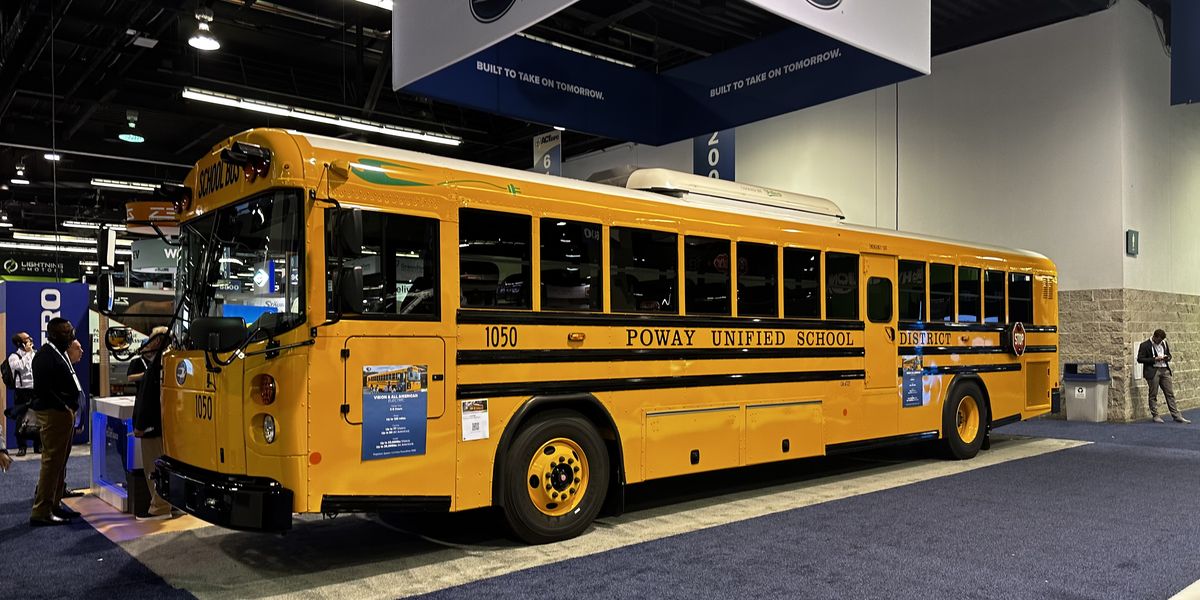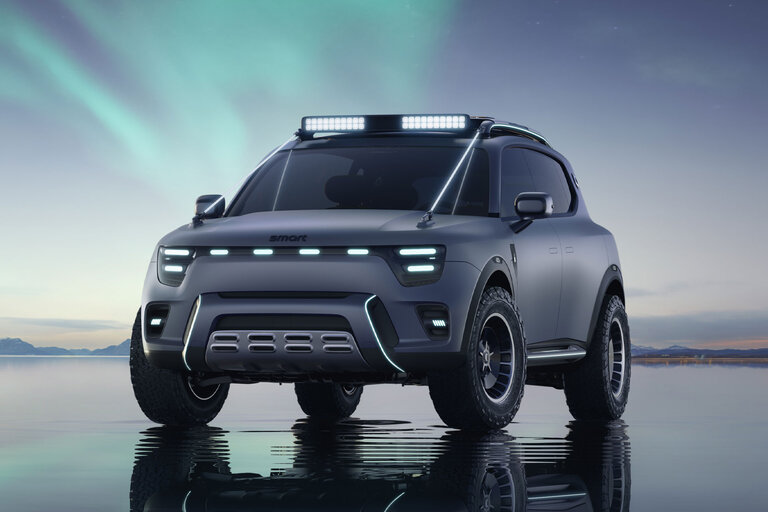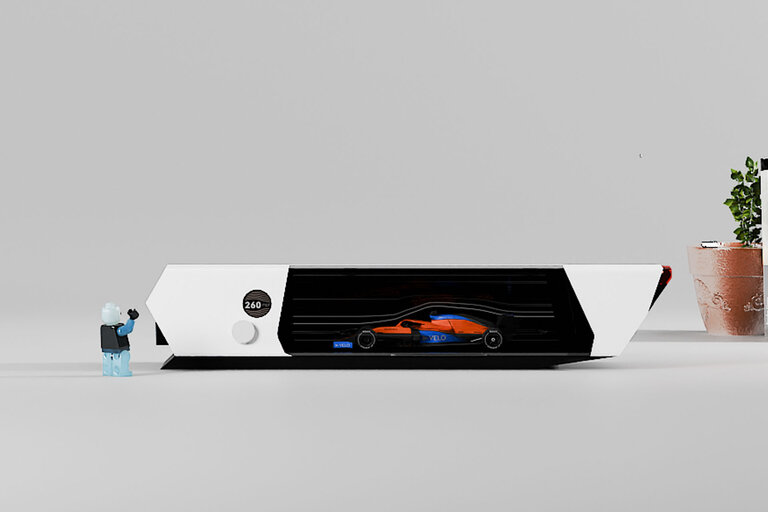
- Federal—and state and local—funding for cleaner work vehicles is hitting communities across the country. At the ACT Expo this week, electric school bus companies were happy to show off their zero-emission options.
- Ford started taking orders for its small Type A bus, built on an E-Transit chassis. Lightning eMotors uses a commercial vehicle platform from GM, Proterra batteries, and its own electric powertrain.
- Electric school buses are used on a schedule that aligns almost perfectly with demand response load balancing, which could provide schools with another way to reduce costs once the technology actually works.
Electric school buses are here. And there. And over there. Last year, 2400 electric school buses were ordered in the U.S., according to the 2023 State of Sustainable Fleets report. That’s not a large percentage of the country’s estimated fleet of 500,000 school buses, but between 2002 and 2026, the Environmental Protection Agency (EPA) will provide $5 billion for cleaner buses, including low-emission technologies like CNG and propane. Companies eager to take part in this growth were on full display at the Advanced Clean Transportation Expo in Anaheim, California, this week.
Battery-powered buses from Blue Bird, BYD, and Lion Electric were scattered on the show floor. The GreenPower Motor Company brought their bus, called the Nano Beast. And Ford announced it will start taking orders for a new school bus upfit kit that works with the all-electric E-Transit model.
Ford offers the E-Transit in three different roof heights and three body lengths and in chassis cab, cutaway, or cargo van models. The electric bus starts life as an E-Transit T-350 chassis cab that uses a 125.0-kWh lithium-ion battery that provides around 120 miles of range. A 180-mile extended-range model will also be available. An average school bus only travels 74 miles a day, but the extended-range option is vital for e-buses to work in rural areas, especially in the winter, explained Christian Kreipke, Ford Pro brand manager for vans (which includes buses).
Ford’s partner Collins installs its Type A School Bus Prep package onto the E-Transit’s rails. The finished bus can carry up to 12 seated passengers, or eight with two wheelchairs, and includes a number of features found on standard school buses, like safety glass and a dual-note horn. The electric powertrain will make a new option possible for the kids. Pro Power Onboard, which can power electronic devices from the EV’s battery, is a popular feature of the F-150 Lightning. It is not currently available to order on the bus, but Kreipke said Ford is scrambling to get it implemented.
Ford Pro Power Onboard for Kids’ Devices
“The reason why we didn’t offer before is, to be frank, we really didn’t see a use case,” Kreipke told Car and Driver. “The main [customer request] is to be able to have jacks so the kids can plug in their laptop, iPhone, or whatever. One of the ways you can achieve that is with Pro Power Onboard.”
Lightning eMotors was displaying its ZEV4 electric bus at the show. To build the EV, Lighting starts with General Motors’ 4500 platform that is used in the GMC Savana and Chevrolet Express. Collins once again provides the yellow box components. Lightning installs its own powertrain – using Proterra batteries – and had to crash test the bus as part of being an approved electric specialty vehicle modifier for GM. Lightning’s vice president of marketing and sales operations, Nick Bettis, told C/D that the company knows one of the most important components it installs might be vehicle-to-grid devices.
“We Don’t Have a Grid Problem—We Produce Plenty of Power”
“People tell me all the time that the grid can’t support electrification. That’s not true,” Bettis said. “We don’t have a grid problem. We’ve got a balance problem. We produce plenty of power. We just do half of it at night when nobody wants it.”
Electric school buses could provide a reliable way to balance the electric load using “demand response,” Bettis said. With vehicle-to-grid technology, electric school buses could charge on low-cost energy during the night, when they’re almost guaranteed to be back at the depot, and they can export some of it back into the grid when they’re parked during the school day, responding to that demand. A 2017-2021 California E-Bus to Grid Integration Project with electric transit buses found that while reliable technology to make this happen is not yet available, simulations proved that once V2G is operational, it would provide bus owners with “positive value” when it comes to utility costs.
EV Buses Will Save School Districts Money
That’s just one way an electric school bus can save a school district money. Commercial vehicles don’t often come with price tags, given the amount of customization that’s common, but electric school buses are expensive, costing hundreds of thousands of dollars. Still, schools that upgrade their diesel buses for electric models can sometimes do so for low or no cost, Bettis said, since the various governments requiring work fleets to get cleaner are providing some funding to make the transition possible. On top of the EPA’s $5 billion, states like California and Colorado have their own incentive programs, and there was more money in the Inflation Reduction Act (IRA), Bettis said.
” If you can get $60,000 for this bus, for example, in California, and another $40,000 from the IRA, you’re looking at $100,000 off a $225,000 bus,” he said. “You can get down pretty close to price parity just with those two things. And there’s no shortage of any of that money.”
Contributing Editor
Sebastian Blanco has been writing about electric vehicles, hybrids, and hydrogen cars since 2006. His articles and car reviews have appeared in the New York Times, Automotive News, Reuters, SAE, Autoblog, InsideEVs, Trucks.com, Car Talk, and other outlets. His first green-car media event was the launch of the Tesla Roadster, and since then he has been tracking the shift away from gasoline-powered vehicles and discovering the new technology’s importance not just for the auto industry, but for the world as a whole. Throw in the recent shift to autonomous vehicles, and there are more interesting changes happening now than most people can wrap their heads around. You can find him on Twitter or, on good days, behind the wheel of a new EV.
#Youre #Electric #School #BusesHeres
Source link





